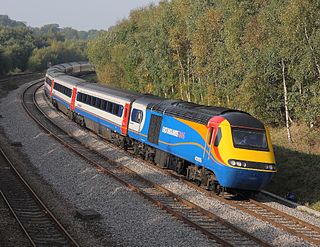
The Midland Main Line (MML) is a major railway line from London to Sheffield in Yorkshire via the East Midlands. It comprises the lines from London's St Pancras station via Leicester, Derby/Nottingham and Chesterfield.

The East Coast Main Line (ECML) is a 393-mile long (632 km) electrified railway between its southern terminus at London King's Cross station and Edinburgh Waverley via Peterborough, Doncaster, York, Darlington, Durham and Newcastle. The line is a key transport artery on the eastern side of Great Britain running broadly parallel to the A1 road. The main line acts as a 'spine' for several diverging branches, serving destinations such as Cambridge, Leeds, Hull, Sunderland and Lincoln, all with direct services to London. In addition, a few ECML services extend beyond Edinburgh to serve Glasgow Central, although the principal London-Glasgow route is the West Coast Main Line (WCML).
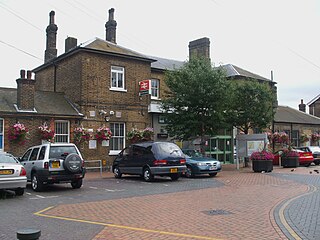
Norwood Junction railway station is a National Rail station in South Norwood in the London Borough of Croydon, south London, and is in Travelcard Zone 4. It is 8 miles 55 chains down the line from London Bridge.
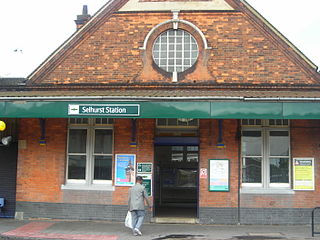
Selhurst railway station is in the London Borough of Croydon in south London, 9 miles 31 chains (15.1 km) along the line from London Victoria. It is operated by Southern, which also provides all the train services. The station is in Travelcard Zone 4.

The Fen Line is a railway line in the east of England that links Cambridge in the south to King's Lynn in the north. The line runs through Cambridgeshire and Norfolk and the name of the line refers to the Fens which cover parts of Cambridgeshire, Norfolk and Lincolnshire. It is 41 miles 47 chains (66.9 km) in length and has eight stations.

Cambridge railway station is the principal station serving the city of Cambridge in the east of England. It stands at the end of Station Road, 1 mile (1.6 km) south-east of the city centre. It is the northern terminus of the West Anglia Main Line, 55 miles 52 chains (89.6 km) down the line from London Liverpool Street, the southern terminus.

Nuneaton railway station serves the market town of Nuneaton in Warwickshire, England. The station is managed by West Midlands Trains. It is served by three railway lines: the Trent Valley section of the West Coast Main Line (WCML), the Birmingham-Leicester-Peterborough line and the Coventry to Nuneaton branch line. It was known, during the period 1924–1969, as Nuneaton Trent Valley, to distinguish it from the now closed Nuneaton Abbey Street station; many local people still refer to it as Trent Valley.

Stevenage railway station serves the town of Stevenage in Hertfordshire, England. The station is around 44.4 kilometres north of London King's Cross on the East Coast Main Line. Stevenage is served and managed by Great Northern, who operate Thameslink stopping services southbound to King’s Cross via stations such as Welwyn Garden City and Potters Bar, to Brighton and Horsham via central London and Gatwick Airport and to Moorgate via Watton-at-Stone, Hertford North and Enfield Chase and services northbound to Cambridge and Peterborough. It is also frequently served by London North Eastern Railway, who operate fast non-stopping services southbound towards London and northbound towards cities including York, Leeds and Edinburgh. Hull Trains and Lumo operate very limited services from the station.

The Hertford loop line is a branch of the East Coast Main Line, part of the Northern City Line commuter route to London for Hertford and other Hertfordshire towns and an occasional diversion route for the main line. The line is part of the Network Rail Strategic Route 8, SRS 08.03 and is classified as a London and South East Commuter line.

The Cambridge line runs from Cambridge junction north of Hitchin on the East Coast Main Line to Shepreth Branch Junction south of Cambridge on the West Anglia Main Line and forms part of the route between London King's Cross and East Anglia. The line is part of the Network Rail Strategic Route 5, SRS 05.05 and is classified as a London and South East Commuter line.

Hitchin railway station serves the market town of Hitchin in Hertfordshire. It is located approximately 1 mile (1.6 km) north east of the town centre and 31 miles 74 chains (51.4 km) north of London King's Cross on the East Coast Main Line.

Welwyn Garden City railway station serves the town of Welwyn Garden City in Hertfordshire, England. It is 20 miles 25 chains from London King's Cross on the East Coast Main Line. Train services are currently provided by Thameslink and Great Northern.
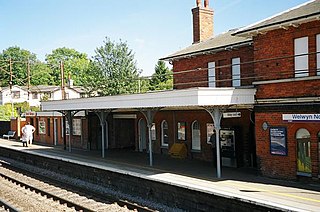
Welwyn North railway station serves the villages of Digswell and Welwyn in Hertfordshire, England. The station is located 22 miles (35 km) north of London King's Cross, on the East Coast Main Line. Train services are currently provided by Great Northern.

Royston railway station serves the town of Royston in Hertfordshire, England. The station is 44 miles 72 chains (72.3 km) from London Kings Cross on the Cambridge Line. Trains serving the station are operated by Thameslink and Great Northern.

The Great Northern route is the name given to suburban rail services run on the southern end of Britain's East Coast Main Line and its associated branches. Services operate to or from London King's Cross and London Moorgate in London. Destinations include Hertford North, Welwyn Garden City, Stevenage, and Cambridge, and in peak hours, additional services run to Peterborough and King's Lynn. Services run through parts of Greater London, Hertfordshire, Bedfordshire, Cambridgeshire, and Norfolk.

The Greenwich Park branch line is a short section of railway line in south east London which links the Catford Loop line to the South Eastern Main Line which originally terminated at Greenwich Park station. It provides a link for freight trains travelling from north London to the south east, as well as a route for passenger trains from London Victoria station to destinations in South East London and Kent.

The Thameslink Programme, originally Thameslink 2000, was a £6 billion project in south-east England to upgrade and expand the Thameslink rail network to provide new and longer trains between a wider range of stations to the north and to the south of London. The development facilitated new cross-London journeys, which means that passengers no longer have to change trains in London. Work included platform lengthening, station remodelling, new railway infrastructure, and new rolling stock. The project was originally proposed in 1991 following the successful introduction of the initial Thameslink service in 1988. After many delays, planning permission was granted in 2006 and funding was approved in October 2007. Work started in 2009 and was completed on 18 September 2020, although trains over the new routes began running in 2018.
The East Coast Main Line Route Utilisation Strategy (RUS), published by Network Rail in February 2008, was the seventh RUS.
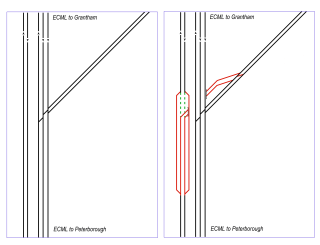
Werrington Dive Under is a replacement dual track grade separated railway junction at Werrington Junction, 3 miles (5 km) north of Peterborough railway station in Cambridgeshire, England. The junction leads to the Great Northern/Great Eastern Joint line (GN/GE) which goes through Spalding to Lincoln and beyond. Completed and opened in December 2021, the dive under allows trains on the west side of the East Coast Main Line (ECML) to access the GN/GE line without conflicting with the faster passenger services on the ECML.

The North Doncaster Chord is a railway connection (chord) between the freight only lines between Hatfield & Stainforth railway station and the Askern branch line, in South Yorkshire, England. The line was built to allow heavy freight trains, mostly from the Port of Immingham, to access the power stations in the lower Aire Valley without the need for them to use the East Coast Main Line (ECML) and creating slower line speeds for faster passenger trains. The chord meant the creation of 2 miles (3.2 km) of new railway and the building of Shaftholme Viaduct, which straddles the East Coast Main Line.





















